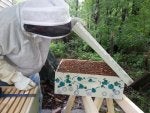As we grew our bee colony count, we went thru all variations of removing bees from frames to be capped.
In the first year, we didn't get any honey to extract. In the next couple of years, we would go to the bee yard with an empty box and a brush, pick out candidate frames, brush the bees off then put them in the empty box covered with a towel. We would come back to the house with anywhere between 4 and a dozen frames to extract in the 2 frame extractor we used at the time.
It was about year 5 when we graduated from 'remove frames' to 'remove boxes'. First time I tried bee escapes I really didn't understand how to use them properly, I put the bee escape on with a fume board, expecting the box to be empty of bees in half an hour. BIG MISTAKE. What I ended up with was a bee escape so plugged with bees they couldn't get out. Then I tried the fume board without the escape, it worked ok, but, not as well as I had hoped, and left an awful smell in the supers.
So then we tried blowing the bees. I was only doing 4 boxes, 2 each off of 2 colonies, and blowing them with the leaf blower worked well, but sure did get us a crowd of angry bees in the air. I thought I had it figured out now, so for the next pull we went to the back lot with a dozen colonies to pull honey off of, and brought the blower. I can almost guarantee, the first time you blow bees from a couple dozen supers in one go, will the last time you want to do it that way. The cloud of angry bees in the air wasn't just a small managable cloud anymore.
In year 7, I learned the correct way to use a bee escape, and it revolves around understanding how the inner workings of the hive go for day to day activities. Foragers bring nectar to the entrance where it's picked up by house bees who eventually move it up to the top. In time, those same bees now move down to the bottom to fetch another load of nectar. The key here is the words 'in time'. in year 7 we tried the bee escapes again, but used differently this time. We place the bee escape under the supers we want to pull, making sure there is enough space below the escape to hold all the bees. For the spring honey flow, this means putting an empty box under the escape. It is important that there are no cracks to provide an entrance into the supers above the escape, painters tape is your friend in this case. Come back in 2 or 3 days, and the honey supers will now be mostly devoid of bees, maybe a couple dozen left in each super.
As you start out with bees, pulling honey is a process that you graduate up thru in stages. Initially, harvest is done 'by the frame'. Only when you get to a larger colony count, and supers are going on as all drawn comb do you start to think about harvesting 'by the box'. It's the same with extracting. We started out with a 2 frame extractor, so our mindset was always 'by the frame'. Only when we graduated to the 18 frame extractor did we start thinking in terms of 'by the box'.
ofc, it doesn't stop there. When you get to a reasonable colony count and are using escapes, the first thing you realize, escapes are a lot of work. First you lift the full boxes off, then you set the escape, now you left those boxes back up on the hive, and it's higher now with the empty under the escape. Come back a couple days later and lift them off again to go onto the truck. Finally when you get home, lift them off the truck and into the extracting facility. That's 4 lifts for every heavy box, and now you start hunting for a piece of equipment that'll take the back work out of that part of the process....
For just a few hives, I would say that brushing individual frames then using a small (2 to 6 frame) extractor is the right way to go. When you get up over half a dozen hives you may want to start thinking about harvesting 'by the box', but, that doesn't work out to well if you aren't using boxes that arrive to the hive with drawn comb. When you get up to a dozen hives with 2 or 3 drawn supers in inventory for each, then you will probably want to be using a larger extractor that fits with a 'by the box' harvesting regime. IMHO, bee escapes are not really suitable for part of your harvest process until you get to the point of harvesting 'by the box'. And when you reach the point that it's multiple boxes per colony, my opinion today is, bee escapes are the easiest way to get bees out of the boxes. BUT, they come with the penalty of multiple lifts per heavy box, and for a yard away from home, it's two trips for the honey harvest.





